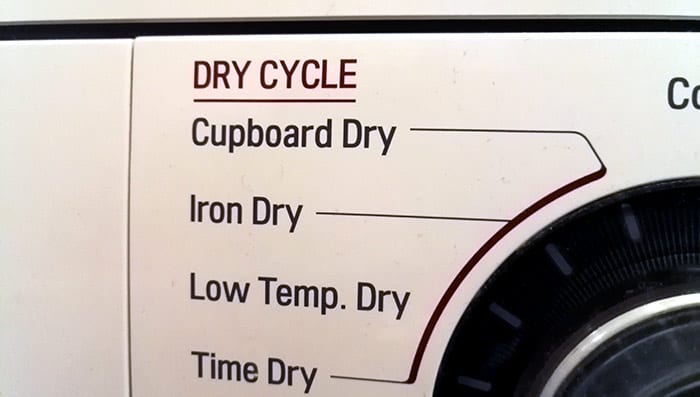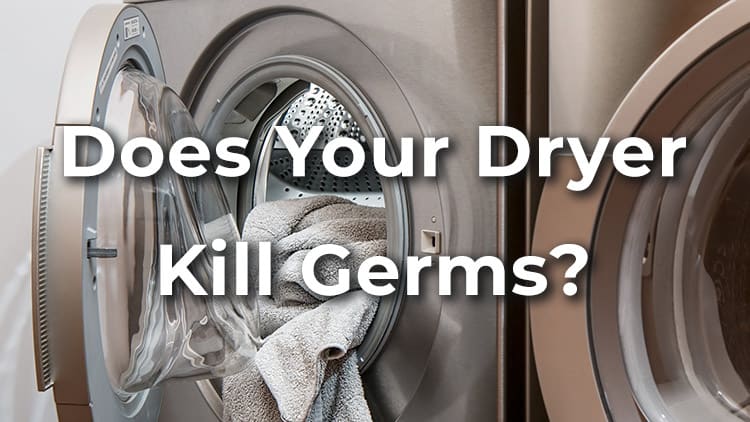I have a tumble dryer in my bathroom and I use it quite often: it eliminates the need for hanging the clothes on the line, therefore it saves me some time. While it’s true that dryers usually consume more energy than washing machines, drying your clothes has many benefits.
Clothes can indeed spread germs. I usually wash my laundry at 80°F and I know that most germs stay alive at that temperature. However, the other day I just wondered if my dryer can make my clothes free from harmful bacteria. So I’ve done some research and read a ton of studies to get a reliable answer. In this article, I’ll share with you what I’ve found.
Do dryers kill bacteria and other germs? Here’s a quick answer:
A dryer can potentially kill the vast majority of germs if it gets hot enough. 135°F is the minimum temperature at which a dryer can significantly reduce the number of bacteria and viruses on your clothes. However, much depends on the length of the drying cycle, the fabrics, and the species of bacteria (and viruses).
Let’s see the details:
How Does a Clothes Dryer Affect Germs?
Clothes dryers are extremely popular in most developed countries. They offer a very convenient and relatively fast way to remove moisture from the laundry. If we want to find out whether they kill bacteria and other pathogens or not, we should first have a quick look at how a dryer works.
There are basically two main types of dryers: ventless and vented dryers. Among ventless dryers, condenser ones are the most widespread.
The most important difference between condenser tumble dryers and vented tumble dryers is the following:
Condenser dryers remove the moisture from the inside of the machine by condensing it into water that’s collected in a container. In contrast, vented dryers pull dry air in from the laundry room and vent out the moist air from the drum through a hose.
Regarding eliminating germs, it’s important to note that all types of dryers heat up the air in the drum to a certain degree to speed up the evaporation process. To varying degrees, all bacterial species are sensitive to heat, as well as other pathogens.
So, in theory, the process is relatively simple: the dryer heats up the air, the warm air heats up your laundry and the bacteria die in the hot environment.
Now, the question is whether the maximum temperature of your dryer is high enough to kill the germs on your clothes.
If you enjoy articles that are both useful and interesting, don’t miss our other posts that give you an answer based on science:
Does Freezing Kill Bacteria?
Can You Microwave Cardboard?
How Hot Does a Dryer Get?

The vast majority of dryers available on the market run at temperatures lower than 150°F. The reason for this is that higher temperatures can potentially damage clothes in the dryer. Manufacturers are well aware of this problem that’s why they design devices that run at safe temperatures.
However, some exceptions can be found: Reviewed.com has performed some measurements in the past few years and the highest dryer temperature they found was 176°F (1).
Apart from a few exceptions, dryer temperatures usually range between 125°F and 135°F (2).
How Can You Find Out the Temperature of Your Dryer?
If you want to know the exact working temperature of your dryer, you should have a look at the user manual as a first step. Sometimes the manufacturer claims the values, however, it’s more common that there is no data in the manual.
Another solution is to measure the temperature of the clothes right after the drying cycle is over and the machine has stopped. You can do this by either placing a meat thermometer in the clothes pile or using an infrared thermometer.
This will give you a good idea of how hot the laundry in your dryer gets.
Note: Do not place or leave a thermometer in a working dryer and avoid thermometers with mercury.
The Temperature You Need Inside the Dryer to Kill Bacteria and Other Germs
There’s only one thing left to do before we can decide if your dryer eliminates any bacteria: we have to examine the exact temperatures at which germs are killed.
Note that we want to kill only harmful bacteria (and other pathogens) that can potentially cause diseases. You don’t need to kill harmless bacteria, they’re literally everywhere and some of them (such as thermophiles) are extremely resistant to heat.
Let’s get back to harmful germs. Luckily, most of them are rather susceptible to heat, though to varying degrees. They’re mostly mesophilic, which means that they like moderate temperatures (they usually thrive between 57°F and 70°F).
If the temperature of your dryer reaches 149°F, you don’t really have to worry about germs because it usually kills the vast majority of them (including most viruses) in just a few minutes (3).
Does that mean that a dryer that runs at 149°F or higher disinfects clothes? Not at all, but it’s unnecessary anyway. Disinfecting means killing ALL living organisms and for that, you would need much higher temperatures.
That’s not what you want because your clothes wouldn’t survive. In contrast, sanitizing is only reducing their number to a safe level (by 99.9% to be exact) (4). That’s a more achievable goal with a dryer that runs at high temperatures for a long enough time.
What If Your Dryer Runs at a Temperature Lower Than 149°F?
To be honest, it’s more likely that the temperature in your dryer doesn’t reach 149°F. This is when things are getting a bit more complicated. While it’s true that you can achieve similar results with lower temperatures, you would need to expose your laundry to heat for a much longer time.
Generally speaking, if you reduce the temperature, you should increase the length of time to get similar results. However, keep in mind that the heat sensitivity of different bacteria species is not the same. Some of them can be killed at 135°F in just a few seconds, while others survive at 145°F for 30 minutes. Fortunately, the latter ones are the minority.
The amount of time and the temperature required to kill harmful microbes also depend on the materials in the fabrics: for instance, clothes made of polyester require lower temperatures and shorter times (5).
So what is the minimum recommended temperature to kill pathogens during the drying process?
If you want to significantly reduce the number of germs on your clothes, your dryer should run at a minimum temperature of 135°F (but you get much better results at 140°F) for at least one hour. If you can choose, always use the high heat setting on the dryer (but first make sure you read the labels on your clothes because high heat may damage certain types of fabrics).
Note that no dryer kills all the germs (so don’t expect yours to disinfect the clothes). There will always be some bacteria or viruses that survive in the dryer. Not to mention some spores (such as the ones of Clostridium species) that can happily survive in boiling water. However, it’s usually not a big deal as there’s very little chance that those left alive on your clothes could cause any harm to you.
Related Questions
Does the Dryer Kill Bed Bugs?
Bed bugs are very unpleasant creatures that can cause a lot of annoyance. Although they multiply pretty slowly compared to other bugs, they can easily spread from one room to another if you don’t stop them.
You may wonder if it’s a good idea to put your bedclothes in the dryer to kill bed bugs. The good news is that heat is a very effective bed bug eliminator: temperatures higher than 120°F kill not only bed bugs but their larvae and eggs too.
However, it’s important that you have to expose bed bugs to that temperature for at least 30 minutes to kill them all. Eggs are usually more resistant: in their case, 90 minutes at 118°F is necessary to destroy them all (6). Of course, at a higher temperature, they require less time.
What About Dust Mites? Do They Survive in a Dryer?
Another good news: you can effectively kill dust mites by exposing them to a temperature of 130°F or higher for at least 15 minutes. So if you use the high heat setting on your dryer you can make your clothes free from dust mites in only a few minutes (7).
Note that allergens (such as feces or decaying bodies of dust mites) can be removed only by washing.
Wrapping It All Up
As you can see, dryers that run at 135°F or higher temperatures can effectively reduce the number of harmful germs. You probably won’t find the maximum temperature of your dryer in the user manual, so you have to measure it yourself if you want to know exactly how hot your device gets. Keep in mind that you should never leave a thermometer in a plugged and working dryer.
If you want to kill bacteria, the length of the drying cycle is critical: as a rule of thumb, the higher the temperature the less time is needed to kill germs. Much depends on the material of the clothes and the species of the bacteria too. You should also keep in mind that no dryer kills all the germs on your clothes. If that is what you want, you should look for another method.











